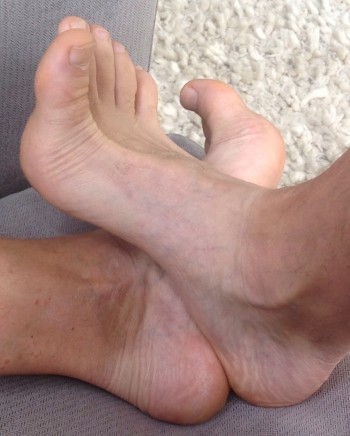Why Feet?
May 28, 2014
 Why?
Why?Have you ever wondered why things are the way they are? For instance, have you ever wondered why your feet have 33 joints in them? Or why there are nerves on the bottom of your feet? Ok, maybe you don't wonder such things. But I do, sometimes more than others.
You intuitively know that you have joints like your elbows and your knees, that are made to move, to bend, to flex and extend. You know you have joints so you can move. So if you know you have joints so you can move, why do the feet have 33 joints in them? Yes! So they can move. But most of the time, many of us don't allow our feet to move. We place them in stiff coffins that don't allow them to bend, articulate, or move like they are designed to move. We splint them. What would happen if you splinted your elbow for 30 years? Do you think it would move well, or function well? Our feet were designed to move. They were never meant to be splinted for a lifetime.
You also know that you have nerves, sensory nerves, so you can feel things, interpret things, and know things. Your sensory nerves paint a picture of rich information for your brain. They nourish your brain and improve your body's awareness, reaction time, and knowledge of your own self. Did you know that the sole of the foot has over 200,000 nerve endings in it? Over 200,000? Why do you think we have so many nerves in the bottom of our feet? So they can tell us things. So they can nourish our brains, sharpen our reflexes, and make us a whole, integrated, poetic being of strength and grace.
Your feet were made to feel the world, nourish your brain, and keep you graceful. Yes, it is true, you were made to be graceful. But how graceful can you be if you blunt, or blind fold, the very instruments that were meant to help you move like flowing water?
The foot also has about 20 muscles. We all know muscles are made for strength, stability, and movement. From a strength training standpoint, if we exercise our muscles regularly, we make them stronger. How is it then that so many people are walking around on weak feet? If we are walking and using the muscles of our feet, how can they be weak? Because we are not using them! Shoes, most shoes, take away the need to use all the muscles in our feet. So, they atrophy and become weak. Even though we walk on them. These muscles don't need to support us because our shoes do, or our fancy inserts do once our shoes no longer offer the support we need. The feet, our feet, should be one of the strongest parts of our bodies. We walk on them, they bear our weight, they support us - at least they should, at least they were made to.
About 20 muscles, 26 bones, 33 joints, and over 200,000 nerve endings. These things live in each one of our feet. Our feet were made to move, to feel, to support, to dance, to be instruments of grace and beauty. They were meant to keep you healthy and strong. They bear your weight, carry you around and they were designed to be fully integrated with your entire body. Your feet are critical to vitality.
If we splint them, if we bury them in a coffin (shoes) for most of our lives, they atrophy, weaken, flatten, stiffen, become dull. Dead things live in coffins. Your feet were made to be alive. They were made to see the world, or at least move in the world. If your feet are dead, how is the rest of you doing? Learn how to awaken and restore your feet. Become a poetic being of strength and grace.
Please note. I am not saying spend the rest of your life barefoot at all cost. Nor am I saying go out and run a 5k barefooted. Believe me, I did that 4 years ago and I wouldn't wish that on anyone! I am only suggesting that you find ways to experience being barefoot - a little bit at a time, often and consistently. Let your feet experience walking in the grass, on the carpet, some other "safe" environment of your choice. If you are concerned about starting too deep, rock barefoot before you crawl. Crawl barefoot before you walk. Walk barefoot before you run. Love your feet. Let them live.
Comments (0)
Please login to comment.